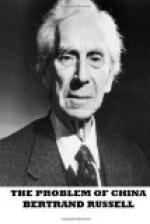I wish I could hope that some respect for “the Master of Dark Truth” would enter into the hearts of our apostles of Western culture. But as that is out of the question, it is necessary to seek other ways of solving the Far Eastern question.
FOOTNOTES:
[Footnote 31: The Truth about China and Japan, Allen & Unwin, 1921, p. 14. On the other hand Sih-Gung Cheng (Modern China, p. 13) says that it “killed twenty million people,” which is the more usual estimate, cf. China of the Chinese by E.T.C. Werner, p. 24. The extent to which the population was diminished is not accurately known, but I have no doubt that 20 millions is nearer the truth than 150 millions.]
[Footnote 32: In January 1922, he came to Peking to establish a more subservient Government, the dismissal of which has been ordered by Wu-Pei-Fu. A clash is imminent. See Appendix.]
[Footnote 33: The blame for this is put upon Sun Yat Sen, who is said to have made an alliance with Chang-tso-lin. The best element in the Canton Government was said to be represented by Sun’s colleague General Cheng Chiung Ming, who is now reported to have been dismissed (The Times, April 24, 1922). These statements are apparently unfounded. See Appendix.]
[Footnote 34: The soya bean is rapidly becoming an important product, especially in Manchuria.]
[Footnote 35: There are, however, no accurate statistics as to the birth-rate or the death-rate in China, and some writers question whether the birth-rate is really very large. From a privately printed pamphlet by my friend Mr. V.K. Ting, I learn that Dr. Lennox, of the Peking Union Medical College, from a careful study of 4,000 families, found that the average number of children (dead and living) per family was 2.1, while the infant mortality was 184.1. Other investigations are quoted to show that the birth-rate near Peking is between 30 and 50. In the absence of statistics, generalizations about the population question in China must be received with extreme caution.]
[Footnote 36: I repeat what everybody, Chinese or foreign, told me. Mr. Bland, per contra, describes Chang-tso-lin as a polished Confucian. Contrast p. 104 of his China, Japan and Korea with pp. 143, 146 of Coleman’s The Far East Unveiled, which gives the view of everybody except Mr. Bland. Lord Northcliffe had an interview with Chang-tso-lin reported in The Times recently, but he was, of course, unable to estimate Chang-tso-lin’s claims to literary culture.]
[Footnote 37: Printed in China in 1918, published by the Peking Leader.]
[Footnote 38: Musings of a Chinese Mystic, by Lionel Giles (Murray), p. 66. For Legge’s translation, see Vol. I, p. 277 of his Texts of Taoism in Sacred Books of the East, Vol. XXXIX.]
[Footnote 39: Waley, 170 Chinese Poems, p. 96.]




